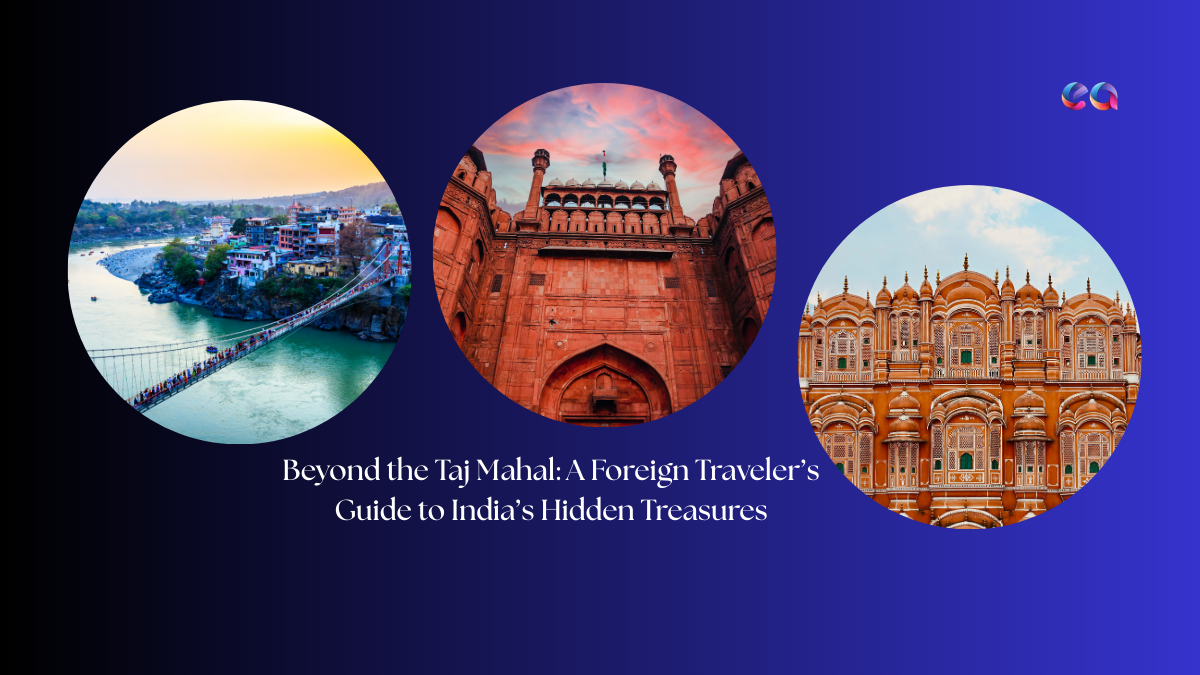
When most people picture India, a few images immediately come to mind: the white marble brilliance of the Taj Mahal, the pink palaces of Jaipur, the beaches of Goa, or the backwaters of Kerala. While these are undoubtedly spectacular, they are only the surface of what India truly offers.
For foreign travelers who dare to wander off the well-trodden path, India unfolds like an endless storybook—every page filled with new cultures, landscapes, and flavors that challenge and delight the senses. From Himalayan deserts to tropical islands, ancient ruins to bustling bazaars, India is a journey not just across miles but across centuries of history and traditions.
This guide is designed especially for foreign travelers—those who may be visiting India for the first or fifth time but want something more authentic than just ticking off landmarks. We’ll cover hidden destinations, cultural etiquette, food adventures, travel hacks, and safety tips to help you experience India as more than just a tourist.
So pack your curiosity (and some comfortable walking shoes)—let’s go beyond the Taj Mahal.
Table of Contents
India Through Foreign Eyes: What Makes It Different
One of the first things visitors notice in India is its contrast. Step out of a luxury hotel in Delhi and you might find yourself walking past ancient ruins, street vendors selling sizzling snacks, and rickshaws weaving between modern cars. This coexistence of the old and new is what makes India so fascinating—and sometimes overwhelming—for foreigners.
- Diversity Everywhere: India isn’t just one country; it’s more like a continent. There are over 22 official languages, hundreds of dialects, and every state feels like a different country with its own food, traditions, and even clothing styles.
- Spiritual Magnet: Many foreign travelers come seeking yoga retreats, Ayurveda treatments, or spiritual solace. Whether it’s meditation in the Himalayas, attending a Ganga aarti (river prayer ceremony) in Varanasi, or exploring Buddhist monasteries in Ladakh, India has a deeply spiritual pulse that can’t be ignored.
- Modern vs Traditional: In metros like Mumbai or Bengaluru, you’ll find rooftop bars, designer malls, and tech startups. But just a few hours away, rural villages still follow age-old customs, rituals, and farming traditions.
This blend is what makes traveling in India unique—you’re never experiencing just one era, but many at the same time.
Hidden Destinations Foreigners Rarely Visit
Most foreign travelers visit India’s “Golden Triangle” (Delhi, Agra, Jaipur), Goa, and Kerala. But the real charm of India often lies beyond. Here are some offbeat destinations worth adding to your itinerary:
- Spiti Valley, Himachal Pradesh
- A cold desert in the Himalayas dotted with centuries-old monasteries like Key and Tabo.
- Perfect for adventure travelers who enjoy high-altitude treks and dramatic landscapes.
- Less crowded than Leh–Ladakh but equally breathtaking.
- Majuli, Assam
- The world’s largest river island, floating in the Brahmaputra.
- Famous for its satras (Vaishnavite monasteries) and vibrant tribal culture.
- Best explored on a bicycle, meeting artisans who make traditional masks and pottery.
- Hampi, Karnataka
- A UNESCO World Heritage Site filled with boulder-strewn landscapes and the ruins of the Vijayanagara Empire.
- Popular among backpackers for its relaxed vibe, cafes, and scooter rides through surreal scenery.
- Meghalaya
- Known as “the abode of clouds,” this northeastern state offers living root bridges, waterfalls, and some of the cleanest villages in Asia.
- A paradise for nature lovers and cavers.
- Chettinad, Tamil Nadu
- Famous for its palatial mansions, heritage architecture, and fiery cuisine.
- A cultural treat far from the usual tourist circuit.
Exploring these places gives foreigners a chance to experience India beyond stereotypes—authentic, raw, and unforgettable.
Cultural Etiquette & Customs for Foreign Travelers
India is welcoming, but culture here runs deep. Knowing a few basics will help you avoid misunderstandings:
- Greetings: Saying “Namaste” with folded hands is always safe. Handshakes are common in cities, but not always in rural areas.
- Dress Modestly: Especially when visiting temples or rural regions. Covering shoulders and knees is appreciated.
- Shoes Off: Always remove shoes before entering homes and temples.
- Eating Etiquette: Use your right hand for eating, as the left is considered unclean.
- Public Affection: Avoid kissing or hugging in public, particularly in smaller towns.
- Festivals: If you join Holi or Diwali celebrations, be respectful—ask before applying colors or entering private spaces.
Being mindful of these customs not only shows respect but also opens doors to warmer interactions with locals.
Food Journeys Beyond Curry
Many foreigners think of “curry” as India’s signature dish, but food here is far more diverse:
- North India: Think butter chicken, paneer tikka, and stuffed parathas.
- South India: Crispy dosas, coconut chutneys, spicy fish curries.
- East India: Bengal’s fish curries, sweets like rasgulla and sandesh.
- West India: Gujarati thalis, Rajasthani dal-baati-churma, Goan seafood.
💡 Tips for foreigners:
- Street food is amazing but stick to stalls with high turnover (fresh food, fast service).
- Drink bottled or filtered water only.
- Carry hand sanitizer and avoid raw salads unless you’re at a high-end restaurant.
Food in India isn’t just about eating—it’s an experience, from busy night markets to home-cooked meals at a village homestay.
Transportation & Getting Around
India’s size can be intimidating, but travel here can be part of the adventure:
- Indian Railways: Slow but iconic. Booking a sleeper train or Rajdhani express is an experience in itself.
- Domestic Flights: Best for covering long distances quickly. Budget airlines like Indigo and SpiceJet are reliable.
- Tuk-Tuks & Rickshaws: Fun for short city rides. Always negotiate the fare or insist on the meter.
- Ride-Sharing Apps: Ola and Uber work in major cities and are safer than hailing random cabs.
- Road Trips: If you’re adventurous, renting a car with a driver can open up amazing landscapes—like the coastal Konkan belt or Rajasthan’s desert roads.
Health, Safety & Comfort Tips
- Water Safety: Stick to bottled or filtered water. Avoid ice unless you’re sure it’s purified.
- Food Hygiene: “Delhi belly” is real. Start slow with spicy food until your stomach adjusts.
- Women Travelers: India is safe for women but requires precautions—dress conservatively, avoid isolated areas at night, and use trusted transport.
- Scams: Common ones include fake guides, overpriced taxis, and shopkeepers claiming “government emporium.” A little research goes a long way.
- Travel Insurance: Always worth it for medical emergencies.
Immersive Experiences Foreign Travelers Love
Instead of just sightseeing, immerse yourself in local life:
- Cooking Classes: Learn how to make chapatis, curries, or chai with a local family.
- Homestays: Offers authentic hospitality that hotels can’t match.
- Volunteering: Many NGOs welcome short-term volunteers in teaching, farming, or conservation.
- Festivals: Join Holi in Vrindavan, Diwali in Varanasi, or Onam in Kerala for unforgettable memories.
These experiences often become the highlights of a trip, giving you stories far richer than any photo album.
Conclusion
Traveling in India isn’t about checking off monuments—it’s about immersing yourself in its rhythm, contrasts, and chaos. The Taj Mahal will always be majestic, but the true beauty of India lies in its lesser-known corners, its street food stalls, its quiet temples, and the warmth of its people.
For the foreign traveler who looks beyond postcards, India is not a destination—it’s a transformation.













